Haft-sin
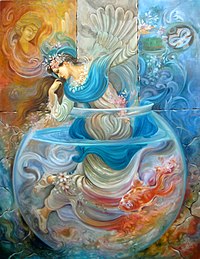

Haft-sin or Haft-seen (Persian: هفتسین) is an arrangement of seven symbolic items whose names start with the letter "س" pronounced as "seen" the 15th letter in the Persian alphabet; haft (هفت) is Persian for seven.[1][2] It is traditionally displayed at Nowruz, the Iranian New Year, which is celebrated on the day of the vernal equinox, marking the beginning of spring on the Northern Hemisphere.
Items of Haft-sin[]
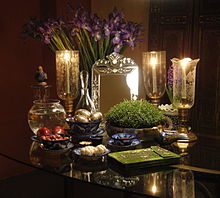
The following are the primary items of Haft-sin, whose Persian names begin with the letter sin in the Persian alphabet.[1][2]
- Sabzeh (سبزه) – wheat, barley, mung bean, or lentil sprouts grown in a dish.
- Samanu (سمنو) – wheat germ sweet pudding.
- Senjed (سنجد) – Oleaster
- Serkeh (سرکه) – vinegar.
- Seeb (سیب) – apple.
- Seer (سیر) – garlic.
- Somāq (سماق) – sumac.
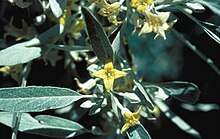

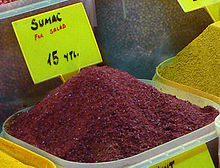
Coins (سکه sekke), hyacinth (سنبل sonbol), and clock (ساعت saat) are sometimes included too. Other symbolic items that are typically used to accompany Haft-sin include a mirror, candles, painted eggs, goldfish, and traditional Persian confections.
A "book of wisdom" is also commonly included, which might be the Quran, the Bible, the Avesta, the Shahnameh, or the Divān of Hafez.[1]
Symbolic Roots of Haft-sin[]
The Haft-Seen table represents nature. By tradition, Iranian families take great pains to create the most beautiful Haft-Seen table that they can, for not only does it embody values both traditional and spiritual, it is also appreciated by the visitors during Nowruz visiting exchanges as a reflection of the families' aesthetic sense and good taste.
Items that start with Persian letter "س":
- Sabzeh (سبزه): Sprouting /Grass: the symbol of rebirth and growth.
- Samanu (سمنو): Samanu: the symbol of power and strength.
- Senjed (سنجد): Elaeagnus angustifolia: the symbol of love.
- Somāq (سماق): Sumac: the symbol of sunrise.
- Serkeh (سرکه): Vinegar: the symbol of patience.
- Seeb (سیب): Apple: the symbol of beauty.
- Seer (سیر): Garlic: the symbol of health and medicine.
Other items that start with Persian letter "س" that are sometimes included:
- Sonbol (سنبل): Hyacinth: the symbol of spring's arrival.
- Sekkeh (سکه): Coin: the symbol of wealth and prosperity.
- Saat (ساعت): Clock: the symbol of time.
Items that don't start with "س" but, nonetheless, are invariably included:
- Tokhm-e Morg Rangi (تخممرغ رنگی): Eggs: the symbol of fertility.
- Ayina (آینه): Mirror: the symbol of self-reflection.
- Shem'a (شمع): Candle: the symbol of enlightenment.
- Maahi-ye Qırmız (ماهی قرمز): Goldfish: the symbol of progress.
- Ketaab (کتاب): Book: the symbol of wisdom.
Afghan Haft Mewa[]
In Afghanistan, people prepare Haft Mēwa (Persian: هفتمیوه) (literally translates as Seven Fruits) in addition to or instead of Haft Seen which is common in Iran. Haft Mewa is like a fruit salad made from seven different dried fruits, served in their own syrup. The seven dried fruits are: raisins, Senjed (the dried fruit of the oleaster tree), pistachios, hazelnuts, prunes (dried apricots), walnuts and either almonds or another species of plum fruit.
Gallery[]

Wheatgrass, one of the items of Haft-sin.

A bowl of samanu, one of the items of Haft-sin.

Goldfish, one of the items of Haft-sin.

A Haft-sin table at the White House.
A Haft-sin table at a hotel in Bijar, Kurdistan.

A Haft-sin table at Sharif University of Technology.

A Haft-sin table.

A Haft-sin table.

A Haft-sin table.

A Haft-sin table.

A Haft-sin table.

Haft Mewa

A Haft-sin table.

A Haft-sin table.
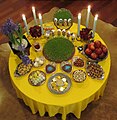
A Haft-sin table.

Haft Mewa
See also[]
- Passover Seder plate, an aesthetically similar (except for its element of animal sacrifice, a practice strictly banned by Zoroastrians) display for the Jewish holiday of Passover.
- Twelve-dish Christmas Eve supper
References[]
External links[]
| Wikimedia Commons has media related to Haft-Seen. |
- Shahbazi, A. Shapur (March 1, 2012). "HAFT SIN". Encyclopaedia Iranica. Vol. XI. pp. 524–526.
- Nowruz
- Ceremonial food and drink
- Persian words and phrases















